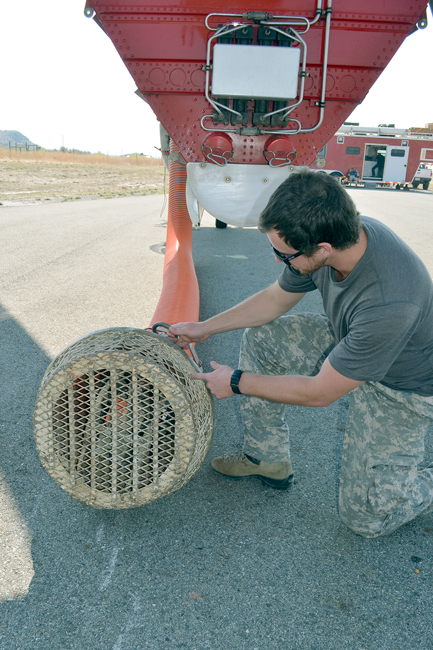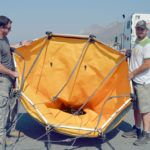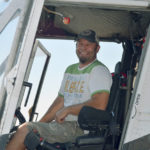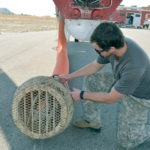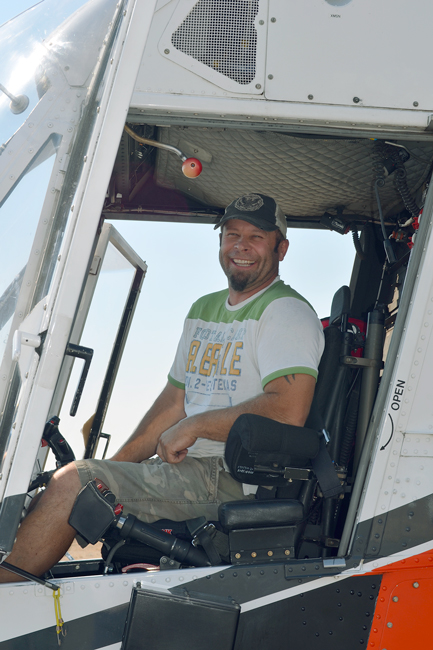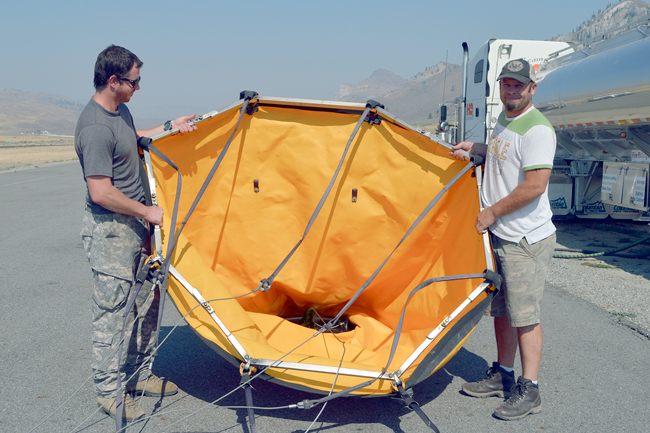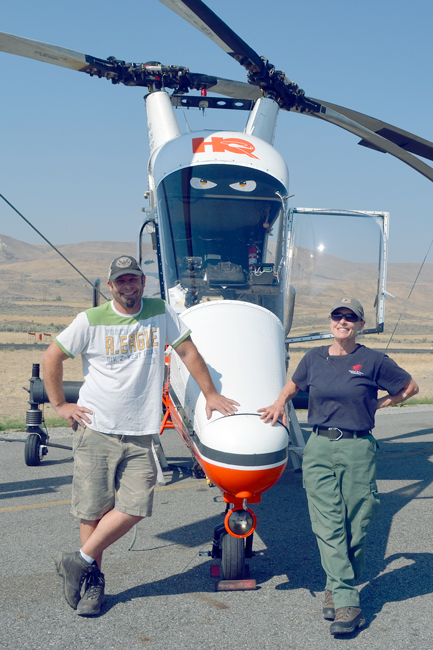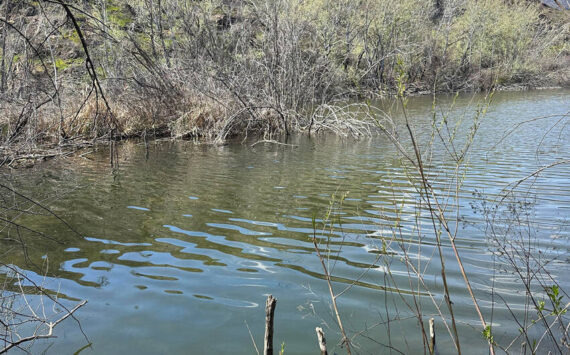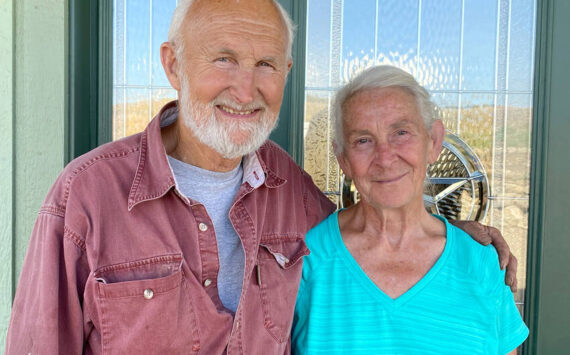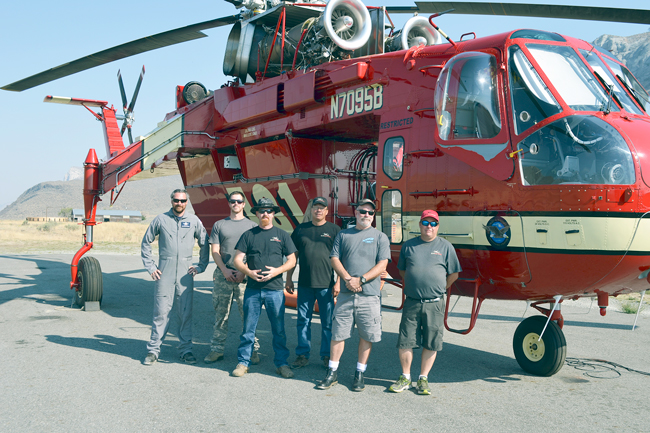
TONASKET – Tonasket Municipal Airport is serving as a helibase for four helicopters this summer as firefighting efforts continue on the Okanogan Complex of fires.
The helicopters are a Type -1 Sky Crane and K-Max used for initial attack (IA) and extended attack air support; a Type-2 Bell 205 “huey” for IA, deployment of Rappellers, troop transport, overall logistics of moving people and gear, and water drops; and a Type-3 Astar used for 1A, logistics support, aerial recon and air resource coordination and water drops.
“The Type-3 Astar serves as an eye in the sky,” said Andrew Hastings. “It is such a really big help to give us an overview of what is going on.”
Hastings is a USFS employee ordered to the helibase as a helicopter manager of the Sky Crane helicopter crew and to act as a liaison between them and the USFS.
The helicopters are privately owned by companies around the nation, and contracted by the USFS, BLM and State fire management departments.
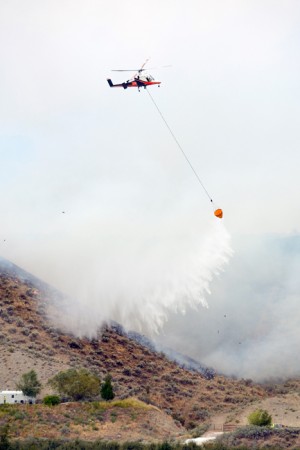
The Sky Crane is under a 90-day contract of 14-hour days with Siller Helicopter, whose headquarters are in Marysville, California. Based in Grant’s Pass for the duration of the fire season, the Sky Cranes go anywhere in the U.S. It arrived in Tonasket August 31, and has been here since, with two eight-man crews working shifts of twelve days on and twelve days off.
“We are not the end of all ends in firefighting; we are just one part of the process,” said Sky Crane Pilot Don Anderson. “Any heroes are the ones on the ground; out there in the dirt. We are flying in clean air, and they are down there in the dirt putting life and limb at risk.”
Anderson has been flying 28 years and started working with Siller Helicopter this summer. He said the helicopters were at the beck and call of Incident Command and ground crew.
“We are just one small part of a very big and complex problem. We are noticed more because we are so visible, but we are just part of the process; and a fire this big has so many players,” said Anderson.
California Fire Team #1 just transitioned in, led by Incident Commander Mike Minton. The Incident Command base is set up at the Omak Stampede Grounds.
The Sky Crane is a Sikorsky CH54A. Designed and built in the 1960s as a military aircraft, it saw action in the Vietnam War.
“It was designed by Sikorski and first flown in 1962 under a Department of Defense contract for lifting heavy cargo,” Anderson said of the ship that has a max gross weigh certification of 42,000 pounds. “This one is modified and adapted specifically for USFS service, working firefighting. It has a 2,500 gallon tank, and has hoverfield capabilities to collect from streams, rivers and lakes.”
“Water drops are a game-changer for guys on the ground,” said Hastings, who also works fires as a rappeller.
He said parameter studies done on how effective different approaches were in fighting fires, found fires with zero to four foot flames to be effectively fought by ground crews; fires with four to eight foot flames by dozers with the ability to spray water; and flames over eight feet tall by helicopters and fixed-wing aircraft.
“Fire can sometimes have flames that reach over 200 feet in the air, and they can also throw burning material so high and far into the atmosphere that it can start other fires, called spot fires; many of them ten to twenty miles in front of itself. When this type of fire behavior is happening, Incident Command Teams usually take a ‘Big Box’ approach,” said Hastings. “Fire fighter and public safety are number one, and protecting anything important in the area. Weather changes are great, but we also work off large natural fuel breaks and terrain; sometimes performing burn out and back burns to eliminate fuel out in front of a fire. Establish these lines in the right places, and you can stop a large, very active fire. During these types of fire fighting tactics is where hard-working ground forces and water drops/retardant drops from helicopters and fixed wing air tankers play critical roles.”
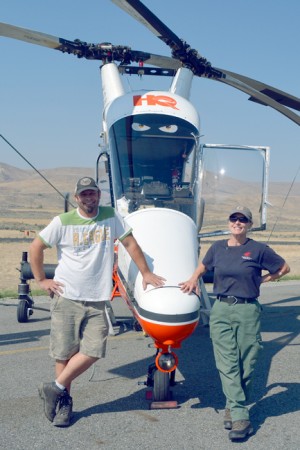
“A contained fire is different than a controlled fire,” said Andrews. “With a contained fire, you put a line around the fire; either a hand line dug with hand tools, or a dozer line. Then you back-burn towards the fire to get rid of fuels so it can’t burn further. It’s another effective tool.”
Hastings said a weather change can allow a ground crew to get in, and save money on not having to fly the helicopter. The Sky Crane runs about $7,600 per hour, and is also one of the more expensive helicopters on contract.
“With the Sikorski and the K-Max, ground crews will work areas along a hot edge of a fire where they are cutting fuel breaks. A helicopter can get in there to put out spot fires and cool the hot edge enough to allow ground crew to get in and extinguish it further,” Hastings said.
He said often ground crews were on firelines where the ambient temperature was 95-100 degrees. “Then you put them next to what is basically a large campfire, and they can only stand it for so long. The water drop changes the local environment on the ground. It increases the humidity and leaves water dripping off the trees.”
Hastings said while the ground crews weren’t effective against the large flames, the helicopters weren’t completely effective against everything either. “The helicopters need the ground crews, and the ground crews need the helicopters. It’s a team effort.”
K-Max pilot Phil “Spanky” Melton, flying for HeliQwest, has been assigned to the Okanogan Complex since mid-August; working shifts of twelve days on and twelve days off.
“The K-Max and a FireHawk were the first planes to arrive in Omak,” said Melton, who has over 5,000 hours of flight time on the K-Max. The K-Max is contracted through Team HeliQwest, an international Helicopter Charter Company that specializes in operations such as forest fire suppression.
Melton said so far, only 36 K-Maxes were built in the 1990s; but six more are scheduled to be built at a cost of $6.5 million each.
Melton said he was in Afghanistan when three of the K-Max helicopters were converted to remote and used to provide supply drops. He is one of just three pilots who checked out to be a safety pilot on the remote.
“I was inside the K-Max while it was hooked up to a computer, but only for maintenance. When we fired it up, we got out,” said Melton. “To fly it, you just picked up a playstation remote and started driving it. It’s really simple; you build a flight plan and it flies autonomously. It’s the perfect platform for that, because it lifts so much weight.”
The max gross weight is 12,000 pounds, with a hook weight of 6,000 pounds. The water bucket holds up to 690 gallons.
“It’s nice because it’s designed to do multiple partial drops, and you don’t have to let all the water out at once. Which is good; because if I miss, I can fly back over with a little bit left and it doesn’t look so bad,” Melton said with a laugh.
He recalled one of his favorite firefighting assignments this summer was dropping water on the McLaughlin Canyon fire August 21 as it crept westward over a ridge and came very close to several homes.
“That was fun, there by the Janis Bridge; because it was such a short, fast run,” said Melton, who was dipping the water bucket in the Okanogan River. “This machine really shines in the short distance.” Melton had to leave the fireline when he came close to running out of fuel.
He said the K-Max is dispatched when ground support teams say they need air support, and contact the helibase. A fire team is put in place through Incident Command, and Helicopter Manager Kim Knox, a USFS employee and COR with HeliQwest, gets the order and ground contacts.
“We answer to her, and she answers to helibase,” said Melton. “But the first morning we were here, we showed up at the Omak Airport and there were flames all around the fuel truck. We didn’t wait for orders. We did what we had to do to protect our stuff.”
“It was ‘Game On,’” said Knox. “Very dramatic.”
